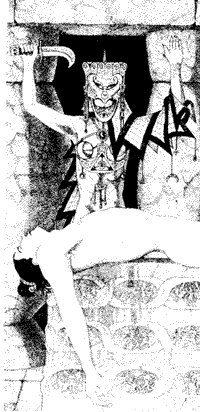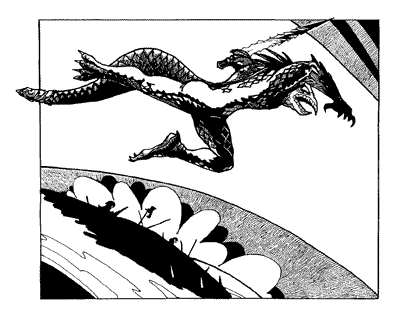The Eye of All-Seeing Wonder
Issue Six | Winter 1996
Joyful Sitting Amongst Friends
There’s quite a mixture of letters this Issue. Let’s start with some points raised by Issue 5.
 Fred Goering: I enjoyed the article on Celestial Harmonics. It reminded me of a three-part article on Tékumelyani Astronomy by Tsomukh Bakal that appeared in the Imperial Courier c.1985. I haven’t implemented it as yet in my campaign, but plan to try it out with any new characters after my schedule calms down a bit.
Fred Goering: I enjoyed the article on Celestial Harmonics. It reminded me of a three-part article on Tékumelyani Astronomy by Tsomukh Bakal that appeared in the Imperial Courier c.1985. I haven’t implemented it as yet in my campaign, but plan to try it out with any new characters after my schedule calms down a bit.
For some reason, Tsolyáni Astrology is a popular subject as you’ll see from this Issue. I find that it can add a lot of colour if used correctly. As Ian March points out in this Issue, it’s not enough just to have some rules; you have to be able to improvise a reading around what the rules tell you.
Fred: In general I liked the article on the Aspects of Lord Thúmis. About 30% of the characters in my campaign are followers of the Grey Lord or His Cohort, and we’ve already adopted some of the Aspects defined in the article. I do have some comments.There were no Tsolyáni proper names given for any of the Aspects, and some Aspects in the article don’t agree with published reference sources (Man of Gold, Imperial Courier, etc.). For example, Thúmis’ 9th Aspect is given as the Hidden Seeker of Eternal Knowledge ("cloistered bookworms"), while other sources say it is Feshmu’un, Tutor of the Gods . Likewise, the 13th Aspect in the article is the Benign Hands, a healing Aspect, while Chuharem the Diviner (a researcher or seer?) is given elsewhere. Two other Aspects I found references to, but no numerical designation, were the Jewelled Serpent (Aspect 40, He Who Treads the Vile One), and Chaisholen the Imparter, giver of knowledge and aid to students. No mention is made of Lord Chaisholen in the article. It has been mentioned elsewhere that Aspects change from time to time, in importance within the Temples. Is this the case? Have the above Aspects slipped in popularity and been replaced since my reference sources were published?
You’re right, and I think you’re highlighting an interesting point. The Eye is not an official Tékumel publication and consequently I don’t have any way to check material against "real" Tékumel but, as MARB has said, everyone has their own Tékumel and that’s no bad thing. There are undoubtedly more errors than this but, as you pointed out, you can still use it as material for a great game. But now on to other matters.
Dermot Bolton: I hear that on Tékumel prime (the Profs game) the Mu’uglavyani have taken control of much of Livyánu after a mysterious plague there. Do you have any idea how such a plague occurred, is it natural or magical? How could the temples allow it to happen in the first place? We all know of the sorcerous prowess of the priests of Tsamra couldn’t they have stemmed the invasion from the north?
It just seems a little improbable to me that the most ancient of the five empires could succumb to a Mu’uglavyani invasion, especially when they have troubles with the Pe Choi, Tsolyáni and are busy slaughtering the Pachi Lei. And did they go around the Tinaliya enclave or through it? Too many unanswered questions!
It’s always tempting to put such things down to malicious, scheming minds but I would think that the Mu’uglavyani would be too honourable to take such an underhand approach. Moreover, I doubt if their best sorcerers are a match for the Livyáni. I think that the plague is natural. Such things do occur, like the Black Death. The Red Hats have merely capitalised on this and are putting the boot in while the man is down.
Paul Mason: A big problem with a lot of published EPT stuff is the frequency of comments along the lines of ’such-and-such has been covered elsewhere’, when the ’elsewhere’ in question is out-of-print. Having the sourcebooks available as netbooks (thanks to the efforts of Chris Davis et al) will make a huge difference. After all, how long is it since the last third of the Zocchi sourcebook was available?
I quite agree. No one is going to use Tékumel as a background if most of the material is unavailable. Netbooks make the material widely and easily available.
Paul: There are a number of comments in the letters column of Issue 5 about Divine Intervention. Dave’s comment about imitating the actions of a god is spot on. I’m reading Karen Armstrong’s ’History of God’ at the moment, and it’s a recurrent theme that emerges in both monotheistic and pagan religion. It’s based on a concept of the divine which may be out of place on Tékumel, though, since it really relies on the idea of an immanent god. In other words, by imitating gods actions you become closer to god, more like god, and more able to find god inside you.
Still, other justifications can be found, and it is, at least, a religious solution rather than a mechanical one!
I feel a little worried about the idea of ’attracting the attention of gods’, because I feel that any god worth his or her salt already knows what you’re doing. But on reflection, this doesn’t necessarily apply to the Tsolyáni deities, does it, as Pavar so graphically described. I think the point to clear up on this is whether DI is a conscious intervention by the deity, or whether it reflects divine power being tapped in some way (e.g. the spirit contracts I mentioned, or the ’attuning’ Dave referred to). I feel a lot more comfortable with a ’non-volitional’ model of DI than with the idea that I have to role-play Vimuhla. I prefer to keep the precise nature and ambitions of Vimuhla et al as hazy and uncertain as possible, not just for the players but for myself as referee.
The difference may be that, unlike on our own world, the gods on Tékumel are real. They have to demonstrate their powers to encourage belief in themselves. Maybe DI doesn’t depend on how faithful a worshipper you are but on whether the result will further the aims of the god in question. These aims may well be beyond the ability of humans to understand. For example, a minor civil servant may get DI because the god knows that he will eventually become Provost of the High Chancery and allow a particular temple to be excluded from a ditlana so that five centuries later a young scholar at that temple will discover...well, I guess you get the picture.
Paul: The interview with Barker was fascinating, but there was one point I found a little amusing: the Professor’s implied comment that all Livyáni are ’far from "rough-hewn"’. I wonder if an entire nation can be ’overly elegant, overly mannered...’ etc. Now I appreciate that the focus of most peoples’ games will be on the Livyáni nobles, but having been given the opportunity to play a Livyáni scumbag (Karunaz) as my first ever character, I’m more interested in what the lower orders are like. Here I’d look at the ’French courtier’ example the professor puts forth. The average French man-at-arms in the Middle Ages would not have been significantly more ’refined’ than his English counterpart. Clearly there will be certain cultural differences (Karunaz was more deferential than the average Tsolyáni, I think, but combined it with the contempt the professor alluded to, resorting to irony whenever possible) and these are where we can find the ’everyday’ Livyáni. I always felt that the habit of eating alone was significant. We hear a lot about the national characters of the Five Empires and elsewhere, and these I accept as stereotypes held within Tékumel, but they seem to focus mainly on the upper classes. I’m interested in differences between the lower orders.
I think it may be a mistake to think that the Tsolyáni and the Livyáni are as similar as the English and the French. Maybe the two cultures are quite different. The Livyáni have been a stable society for millenia, and it may be that they’ve evolved a system of mutual tolerance or a way of respecting other people’s points of view. The Tsolyáni may well interpret this as "overly mannered". The "overly elegant" jibe may simply mean that their fashions are not to Tsolyáni taste.
Several people have voiced opinions on the format of Tékumel rulebooks.
Bill Chambers: I took a look at Skyrealms of Jorune, now in its 3rd edition. It’s very much a poor man’s EPT but it seems to have had much more success than Tékumel, including even a computer game version. The reasons are pretty obvious: good layout, clear introduction, explanation of the lore and history of the place, and plenty of material to get a campaign started.
Contrast that with Gardásiyal, which doesn’t make any effort to be a stand-alone game. Even with all the solo books and the Bestiary (a total outlay of $129!) a newcomer would still have trouble starting up a campaign. Why didn’t they just Issue a 2nd edition Empire of the Petal Throne with updated rules?
Can’t say that I disagree, Bill. Rules will only sell to a mass-market if they are clear, complete and easy to understand. The SoJ people understand this. Some others don’t. I like the idea of a 2nd edition of EPT. As a system I don’t think it’s any worse than most others and revising it—as opposed to reinventing it—would just help to make it better.
Mike Havant: What’s the point of publishing a role-playing game on paper anyway? Why not just put it on the net as shareware and get around the hassle of print costs and distribution? With a minority interest game like EPT you could reach more players that way. And the game could include character generation programs and lots of other stuff that wouldn’t fit in a book.
That’s an opinion, Mike, that I support whole-heartedly too. RPGs have to change. They are becoming too complex for the rules to be kept in book form. What better than something that’ll run on a common PC and has the added advantage of confounding the rules lawyers too!.
Next, back to more mundane" matters.
Guy Boyle: That point about the moons—the eye couldn’t register any ambient colour in such dim light. You’d be able to perceive Kashi as pinkish and Gayel as pale green when you looked straight at them, but that’s all.
Unless they have a built-in light source. Tékumel was originally a pleasure resort for the super-rich, and if you’re going to the trouble of terraforming a planet and even installing gravity engines you might as well tart up the moons a bit.
Jack Bramah writes concerning a tastier topic.
Jack: Just a quick note, I tried the recipe for the stew on the back of whichever issue it was, and it tasted pretty good. I discovered a way of adding to the exotic look was to add a few Truffe de Chine potatoes (which are black-purple) to it.
It was #5, Jack. I don’t recommend anything but a cold glass of Singha Beer with the Hmelu salad, though!

